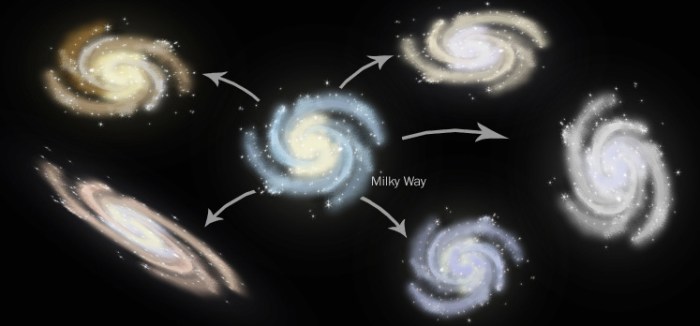What is hubbles law – What is Hubble’s Law? It’s a fundamental principle in cosmology that describes the relationship between the distance of galaxies and their redshift, a phenomenon that indicates how fast they are moving away from us. Imagine looking out at a vast, expanding ocean of space, where galaxies are like boats drifting apart. Hubble’s Law helps us understand the rate at which this cosmic ocean is expanding, revealing the universe’s dynamic nature.
This law, discovered by Edwin Hubble in the 1920s, revolutionized our understanding of the universe. It showed that the universe is not static, but rather expanding, with galaxies moving away from each other at speeds proportional to their distances. This discovery provided crucial evidence for the Big Bang theory, which suggests that the universe originated from a single, incredibly hot and dense point.
Introduction to Hubble’s Law

Hubble’s Law is a fundamental principle in cosmology, revolutionizing our understanding of the universe’s expansion. It describes the relationship between the distance of galaxies and their recessional velocity, establishing that galaxies are moving away from us at speeds proportional to their distance.
This law provides a powerful tool for measuring the vast distances in the universe, revealing the scale and age of the cosmos. It also provides compelling evidence for the Big Bang theory, suggesting that the universe originated from a single point and has been expanding ever since.
The Relationship Between Distance and Redshift, What is hubbles law
Hubble’s Law states that the recessional velocity of a galaxy is directly proportional to its distance from us. This means that galaxies farther away are moving away from us at a faster rate. This relationship can be expressed mathematically as:
v = H0d
Where:
* v is the recessional velocity of the galaxy
* H0 is the Hubble constant, representing the rate of expansion of the universe
* d is the distance to the galaxy
The redshift of light from distant galaxies is a key indicator of their recessional velocity. As a galaxy moves away from us, the light emitted by it is stretched, causing the wavelengths to shift towards the red end of the electromagnetic spectrum. This phenomenon is known as redshift.
Discovery of Hubble’s Law
The discovery of Hubble’s Law was a landmark achievement in astronomy, built upon the work of several pioneering astronomers.
* Edwin Hubble’s observations: In the 1920s, Edwin Hubble, using the powerful 100-inch Hooker Telescope at Mount Wilson Observatory, made meticulous observations of distant galaxies. He noticed a systematic relationship between the distance of galaxies and their redshift, which was interpreted as a measure of their velocity.
* Vesto Slipher’s earlier work: Prior to Hubble’s work, Vesto Slipher, an American astronomer, had already observed the redshift of galaxies, but he did not recognize the significance of this phenomenon in terms of the expansion of the universe.
* Georges Lemaître’s theoretical prediction: In 1927, Georges Lemaître, a Belgian priest and physicist, proposed a theoretical model for an expanding universe based on Einstein’s theory of general relativity. He predicted that the farther away a galaxy is, the faster it should be receding.
Hubble’s observations provided observational confirmation of Lemaître’s theoretical prediction, establishing the foundation for the modern understanding of the expanding universe.
Wrap-Up

Hubble’s Law is a cornerstone of modern cosmology, offering a powerful tool for understanding the universe’s history, its current state, and its potential future. It has led to profound insights into the Big Bang, the expansion of the universe, and the existence of dark energy, a mysterious force that seems to be accelerating the expansion. By studying the redshift of distant galaxies and applying Hubble’s Law, astronomers can measure the age of the universe, map its large-scale structure, and even predict its ultimate fate.
Quick FAQs: What Is Hubbles Law
How is Hubble’s Law used to determine the age of the universe?
Hubble’s constant, which represents the rate of expansion, can be used to estimate the age of the universe by extrapolating back to the time when all galaxies were in a single point. However, determining the precise age of the universe requires accounting for factors like dark energy and the evolution of the expansion rate over time.
What are the limitations of Hubble’s Law?
Hubble’s Law is based on the assumption that the universe is homogeneous and isotropic, meaning it looks the same in all directions. However, the universe is not perfectly uniform, and there are regions where galaxies are clustered together. This can lead to discrepancies in the measured redshift and distance.
What is the role of dark energy in Hubble’s Law?
Dark energy is a mysterious force that is accelerating the expansion of the universe. Its presence has a significant impact on the value of Hubble’s constant and the ultimate fate of the universe. It is believed to be responsible for the universe’s accelerating expansion.
How does Hubble’s Law relate to the Doppler effect?
Redshift, a key component of Hubble’s Law, is related to the Doppler effect, which describes the change in frequency of a wave due to the motion of its source. When a galaxy moves away from us, the light it emits is stretched, resulting in a redshift. This redshift is proportional to the galaxy’s speed.